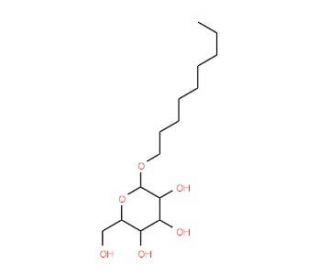

n-Nonyl-β-D-glucopyranoside (CAS 69984-73-2)
See product citations (2)
QUICK LINKS
n-Nonyl-β-D-glucopyranoside, a nonionic surfactant derived from glucose, serves as a versatile tool in scientific research, particularly in the field of biochemistry and molecular biology. Its mechanism of action involves disrupting hydrophobic interactions and stabilizing membrane proteins, making it invaluable in the solubilization and purification of integral membrane proteins. In research applications, n-nonyl-β-D-glucopyranoside is frequently employed for membrane protein extraction and reconstitution, where it aids in maintaining protein stability and activity in vitro. Additionally, it is utilized in the preparation of liposomes and other lipid-based systems for drug delivery and biophysical studies. Its mild detergent properties and compatibility with biological samples make it an ideal choice for studying membrane protein structure, function, and interactions with ligands or other biomolecules. Ongoing research continues to explore novel applications and formulations of n-nonyl-β-D-glucopyranoside, highlighting its significance in advancing our understanding of membrane biology and protein-lipid interactions.
n-Nonyl-β-D-glucopyranoside (CAS 69984-73-2) References
- Aromatic nucleophilic substitution in nonionic alkylglucoside micelles. | Whiddon, CR., et al. 2004. J Colloid Interface Sci. 278: 461-4. PMID: 15450467
- Surfactant diffusion through bicontinuous micellar networks: a case study of the C9G1/C10G1/H2O mixed surfactant system. | Whiddon, C., et al. 2004. Langmuir. 20: 2172-6. PMID: 15835667
- Adsorption kinetics of n-nonyl-beta-D-glucopyranoside at the air-water interface studied by infrared reflection absorption spectroscopy. | Meister, A., et al. 2005. J Phys Chem B. 109: 6239-46. PMID: 16851691
- Adsorption of peptides at the sample drying step: influence of solvent evaporation technique, vial material and solution additive. | Pezeshki, A., et al. 2009. J Pharm Biomed Anal. 49: 607-12. PMID: 19150589
- Variation of the detergent-binding capacity and phospholipid content of membrane proteins when purified in different detergents. | Ilgü, H., et al. 2014. Biophys J. 106: 1660-70. PMID: 24739165
- Nonionic surfactants increase digoxin absorption in Caco-2 and MDCKII MDR1 cells: Impact on P-glycoprotein inhibition, barrier function, and repeated cellular exposure. | Al-Ali, AAA., et al. 2018. Int J Pharm. 551: 270-280. PMID: 30240828
- MRP2-mediated transport of etoposide in MDCKII MRP2 cells is unaffected by commonly used non-ionic surfactants. | Nielsen, S., et al. 2019. Int J Pharm. 565: 306-315. PMID: 31085259
- Detergent effects on the light-harvesting chlorophyll A/B-protein complex crystallization revealed by fluorescence depolarization. | Furuichi, M., et al. 1997. Biochem Biophys Res Commun. 233: 555-8. PMID: 9144576
- Comparison of alkylglycoside surfactants in enantioseparation by capillary electrophoresis. | Mechref, Y. and El Rassi, Z. 1997. Electrophoresis. 18: 912-8. PMID: 9221877
Ordering Information
| Product Name | Catalog # | UNIT | Price | Qty | FAVORITES | |
n-Nonyl-β-D-glucopyranoside, 1 g | sc-281084 | 1 g | $274.00 |
